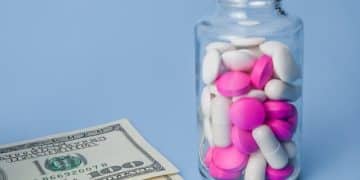Save Money on Medications: Affordable Care & Prescription Drug Costs Strategies

Affordable care and prescription drug costs can be a significant financial burden; however, various strategies, including generic medications, prescription assistance programs, and comparing prices, can help individuals save money on medications and healthcare.
Navigating the landscape of healthcare costs can be daunting, especially when it comes to affording necessary medications. The struggle to balance health needs with financial constraints is a reality for many Americans. Understanding the factors influencing prescription drug prices and exploring available strategies are crucial steps toward achieving **affordable care and prescription drug costs**. This article delves into practical tips and resources to help you save money on medications, ensuring your health doesn’t break the bank.
Understanding the Factors Influencing Prescription Drug Costs
The cost of prescription drugs isn’t arbitrary. Several intricate factors contribute to the prices we see at the pharmacy counter. Understanding these elements can empower you to navigate the system more effectively.
From research and development to marketing and distribution, each stage adds to the final price. Let’s break down some of the key players:
Research and Development
Developing new medications is an expensive and time-consuming process. Pharmaceutical companies invest heavily in research, clinical trials, and regulatory approvals. These costs are often factored into the price of the drug.
Marketing and Advertising
Pharmaceutical companies spend billions of dollars annually on marketing and advertising. These efforts can drive demand and influence prescribing habits, ultimately impacting prices.

Other factors influencing drug costs include:
- Patent Protection: Patents grant exclusive rights to manufacturers, allowing them to set prices without competition for a certain period.
- Competition: The availability of generic alternatives can significantly lower prices.
- Insurance Coverage: Your insurance plan’s formulary, copays, and deductibles play a major role in your out-of-pocket costs.
Understanding these factors is the first step toward finding ways to reduce your prescription drug expenses.
In conclusion, prescription drug costs are influenced by several factors, including research and development, marketing, patent protection, competition, and insurance coverage.
Exploring Generic Medications: A Cost-Effective Alternative
Generic medications are a powerhouse for those seeking affordable healthcare. They offer the same therapeutic benefits as their brand-name counterparts but at a fraction of the cost. It’s a simple, yet powerful way to save.
These medications contain the same active ingredients, dosage, strength, and route of administration as brand-name drugs. The main difference lies in the price tag because generic manufacturers don’t have to repeat the initial research and development phases.
The Safety and Efficacy of Generics
Generic drugs must meet the same rigorous standards as brand-name drugs, as set by the Food and Drug Administration (FDA). Before approval, the FDA ensures that generic medications are safe and effective.
How to Ask Your Doctor About Generics
Don’t be shy, speak up! When your doctor prescribes a medication, specifically ask if a generic alternative is available. Inquire about the potential cost savings and any possible differences in inactive ingredients.
Here are some tips to make the conversation easier:
- Be Proactive: Initiate the discussion about generics.
- Ask Specific Questions: “Is there a generic version of this medication?” “Are there any reasons why the brand-name version would be better for me?”
- Understand the Formulary: Check your insurance plan’s drug list to see if generics are preferred.
By embracing generic medications, you can significantly reduce your prescription drug costs without compromising your health. Small changes in medication choices can lead to big savings.
To conclude this section, Generic medications are a safe and cost-effective alternative to brand-name drugs, offering the same therapeutic benefits at a lower price.
Leveraging Prescription Assistance Programs (PAPs)
For individuals facing financial hardship, Prescription Assistance Programs (PAPs) can be a lifeline. These programs offer medications at reduced costs or even for free to those who qualify. PAPs are a valuable resource for affordable care.
These programs are typically sponsored by pharmaceutical companies and non-profit organizations. They aim to ensure that individuals with limited income have access to the medications they need.
Eligibility Criteria for PAPs
Each PAP has its own eligibility criteria, but common factors include income level, insurance status, and medical necessity. Some programs may also have residency requirements.
Where to Find Information About PAPs
Several resources can help you find PAPs that match your needs. Some popular options include:
Resources to Explore:
- NeedyMeds: A comprehensive website that lists PAPs and other resources for affordable medications.
- RxAssist: An online database of PAPs and discount drug programs.
- Pharmaceutical Company Websites: Many companies have their own PAP information on their websites.

Applying for PAPs may require some paperwork, but the potential savings can be well worth the effort. Be patient and persistent in gathering the necessary documentation and completing the application process.
The assistance programs provide solutions for eligible individuals to afford their medication and support affordable healthcare.
In summary, Prescription Assistance Programs (PAPs) offer a valuable resource for individuals with limited income to access medications at reduced costs or for free.
Comparing Prices at Different Pharmacies
Just like grocery stores or gas stations, pharmacies can vary in their pricing. Taking the time to comparison shop can lead to significant savings on your prescription medications. Knowledge equals potential savings.
Don’t assume that all pharmacies charge the same prices. Different factors, such as location, overhead costs, and contracts with insurance companies, can influence pricing. Don’t be afraid to search around for the best price.
Online vs. Local Pharmacies
Both online and local pharmacies have their pros and cons. Online pharmacies often offer convenience and competitive pricing, but it’s essential to ensure they are licensed and legitimate. Local pharmacies provide face-to-face consultations and personalized service.
Tools for Price Comparison
Several websites and apps can help you compare prices at different pharmacies. Some popular options include:
Sites to use:
- GoodRx: Offers coupons and price comparisons for prescription drugs.
- WellRx: Provides discounts and savings tips for medications.
- Blink Health: Allows you to purchase medications online and pick them up at a local pharmacy.
Remember to factor in shipping costs and waiting times when considering online pharmacies. Also, make sure the website has a VIPPS verification. Look for deals. Don’t assume one pharmacy is the cheapest.
Comparison shop, and seek discounts on the costs of your medicine from different pharmacies. This keeps drug costs manageable.
To conclude, Comparing prices at different pharmacies, both online and local, is a smart way to save money on medications.
Discussing Options with Your Doctor
Your doctor is your ally in navigating the complex world of prescription medications. Open communication is key to finding the most effective and affordable treatment options. This professional collaboration ensures your health does not break the bank.
Don’t hesitate to ask your doctor about alternative medications, lower dosages, or different formulations that may be more cost-effective. They can also help you understand the potential side effects and risks of each option.
Exploring Alternative Medications
Your doctor may be able to suggest alternative medications that are just as effective but less expensive. This could include generic medications or older drugs that have been around for a while.
Considering Lower Dosages or Different Formulations
Sometimes, a lower dosage or a different formulation (such as a tablet instead of a capsule) can be just as effective and more affordable. Your doctor can help you determine if this is a viable option for you.
You shouldn’t be shy when speaking with your Doctor. Here are some questions to ask:
- “What are the potential cost savings of this alternative medication?”
- “Are there any trade-offs in terms of effectiveness or side effects?”
- “Is a lower dosage or different formulation an option for me?”
Building a strong relationship with your doctor and engaging in open communication can lead to better health outcomes and lower healthcare costs.
In the final analysis, Discussing options with your doctor is crucial for finding the most effective and affordable medication treatment plans.
Utilizing Insurance and Discount Cards Effectively
Insurance plans and discount cards are powerful tools to leverage in reducing your medication costs. They can help you navigate complex pricing and access discounts you might not otherwise be aware of. Finding the best insurance is crucial to affordable healthcare.
Understanding your insurance formulary, taking advantage of mail-order pharmacies, and using discount cards strategically can save you money. Don’t leave potential savings on the table; knowledge of your plans is important.
Understanding Your Insurance Formulary
A formulary is a list of prescription drugs covered by your insurance plan. Drugs are typically categorized into tiers, with different copay amounts for each tier. Knowing where your medications fall on the formulary can help you estimate your out-of-pocket costs.
Mail-Order Pharmacies
Many insurance plans offer mail-order pharmacy services, which can be more convenient and cost-effective than traditional pharmacies. Mail-order pharmacies often offer discounts for filling prescriptions in larger quantities.
These are some details to look at for discount cards:
- Compare Different Cards: Not all discount cards are created equal. Compare the discounts offered on your medications by different cards. Websites like GoodRx can help with this.
- Check for Restrictions: Some cards may have restrictions on which pharmacies you can use or which medications are covered.
- Read the Fine Print: Make sure you understand the terms and conditions of the card before using it.
By strategically utilizing your insurance and discount cards, you can significantly reduce your expenses on prescription medications and save loads of money.
In the end, Utilizing insurance and discount cards effectively is an important strategy for lowering medication costs.
| Key Point | Brief Description |
|---|---|
| 💊 Generic Drugs | Use generic versions of drugs as they have the same effect, but cost less. |
| 🤝 Prescription help | Check drug assistance programs for discounted or free medicines. |
| 💰 Pharmacy Prices | Comparison pricing at different pharmacies for potentially lower pricing. |
| 🩺 Speak To Doctor | Your doctor and their expertise can change dosage to lower cost medicine. |
Frequently Asked Questions
▼
Yes, they contain the same active ingredients and meet the same FDA standards for safety and effectiveness. They aren’t marketed under different brand names, so cost can be reduced.
▼
Resources like NeedyMeds and RxAssist offer comprehensive databases of PAPs. Pharmaceutical company websites also provide information on their programs. Be sure to shop around and look into it.
▼
Ensure the online pharmacy is licensed and legitimate. Look for VIPPS verification and check customer reviews. Also, look for reviews about shipping and hidden costs.
▼
Yes, discussing options with your doctor can lead to alternative medications, lower dosages, or different formulations that are more cost-effective. It can be really helpful.
▼
Understand your insurance formulary, utilize mail-order pharmacies, and compare costs with and without insurance and discount cards. Also, stay healthy to prevent the use of medicine!
Conclusion
In conclusion, managing **affordable care and prescription drug costs** requires a proactive and informed approach. By understanding the factors that influence drug prices, exploring generic medications, leveraging prescription assistance programs, comparing prices, discussing options with your doctor, and utilizing insurance and discount cards effectively, you can take control of your healthcare expenses and ensure access to the medications you need.





